Madrid Travel Guide
Written by Joeri Van Overloop
Imagine strolling down charming cobblestone streets lined with centuries-old buildings adorned with intricate ironwork balconies. The melodic sounds of flamenco music fill your ears as you sample delectable bites of Jamón Ibérico at every turn.
This is Madrid - a city bursting with energy and passion at every corner. Whether you're a history buff eager to explore ancient landmarks or a foodie seeking out culinary delights, my personal experience as a traveler will serve as your ultimate Madrid travel guide, helping you navigate this mesmerizing city and uncover its hidden gems along the way
Why Go to Madrid?
Madrid, the capital of Spain, is an amazing and culturally rich city that offers a wide array of experiences and attractions for visitors. Here are several reasons why you might consider visiting Madrid:
- Art and Culture: Madrid is home to renowned art museums like the Prado Museum, the Reina Sofía Museum, and the Thyssen-Bornemisza Museum, which house some of the world's most significant art collections. You can admire works by artists like Goya, Velázquez, Picasso, Dalí, and many more.
- Architecture: Madrid boasts a mix of architectural styles, from historic buildings and palaces to modern and contemporary designs. Visit the Royal Palace, Plaza Mayor, Puerta del Sol, and Gran Vía to appreciate the city's architectural diversity.
- Culinary Delights: Madrid is a paradise for food lovers. Indulge in traditional Spanish cuisine, including tapas, paella, churros, jamón ibérico, and a wide range of regional dishes. Don't miss the local markets like Mercado de San Miguel to savor authentic flavors.
- Nightlife and Entertainment: Madrid is famous for its lively nightlife and vibrant entertainment scene. The city comes alive after dark with numerous bars, clubs, theaters, and live music venues where you can enjoy flamenco shows, concerts, and dance the night away.
- Green Spaces and Parks: Madrid offers beautiful parks and green spaces like Retiro Park, Casa de Campo, and Madrid Rio. These areas provide a relaxing escape from the bustling city, ideal for picnics, leisurely walks, or outdoor activities.
- Shopping: Madrid is a shopper's paradise, offering a range of shopping experiences from luxury boutiques in Salamanca district to lively markets like El Rastro. You can find everything from high-end fashion to unique souvenirs and antiques.
- Sports: If you're a sports enthusiast, Madrid is home to iconic football clubs, Real Madrid and Atlético Madrid. You can attend a match at the Santiago Bernabeu or Wanda Metropolitano stadiums to experience the excitement of Spanish football.
- History and Heritage: Explore the rich history of Madrid by visiting historical sites like the Royal Palace, Almudena Cathedral, and the Temple of Debod. These landmarks showcase the city's fascinating past and cultural heritage.
- Festivals and Events: Madrid hosts numerous festivals and events throughout the year, celebrating traditions, music, food, and more. Events like San Isidro Festival, Madrid Pride, and the Mad Cool Music Festival draw visitors from around the world.
- Local Lifestyle and Atmosphere: Immerse yourself in the local lifestyle, enjoy the cafe culture, take leisurely strolls through charming neighborhoods, and experience the warmth and hospitality of the Madrileños.
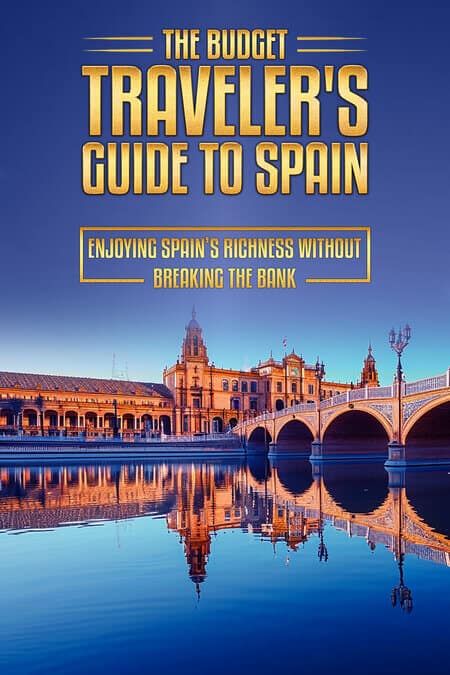
The Budget Traveler's Guide to Spain
Don't let expensive travel costs hold you back from exploring the beauty of Spain. With "The Budget Traveler's Guide to Spain," you'll discover insider tips and tricks to help you save money while experiencing the best Spain has to offer. Start planning your affordable Spanish adventure today and make unforgettable memories without breaking the bank.
Best Time to Visit Madrid?
The best time to visit Madrid depends on your preferences regarding weather, events, and the overall experience you are looking for. Here's an overview of the different seasons and what they offer:
- Spring (March to May):
- Spring is one of the best times to visit Madrid. The weather is pleasant with mild temperatures and blooming flowers, making it ideal for outdoor activities and sightseeing.
- It's a great time to visit parks and gardens, and you can enjoy outdoor events and festivals such as Semana Santa (Holy Week) and the San Isidro Festival in May.
- Summer (June to August):
- Summer can be hot in Madrid, with temperatures often exceeding 30°C (86°F). However, if you're accustomed to warm weather, it's a good time for outdoor activities, festivals, and late-night socializing as the city comes alive with events and open-air concerts.
- Many locals take their summer vacations in August, so some businesses and restaurants may have limited hours or be closed.
- Autumn (September to November):
- Autumn is another excellent time to visit Madrid. The weather remains pleasant, and you'll experience fewer crowds compared to the summer months.
- September is particularly enjoyable with warm temperatures and the city buzzing with cultural events and festivals.
- Winter (December to February):
- Winters in Madrid are mild compared to other European cities, but it can still get quite cold, especially in January and February.
- December is festive with holiday decorations and events, making it a lovely time to experience the city's Christmas spirit. If you enjoy winter activities, nearby Sierra Nevada offers skiing and snowboarding options.
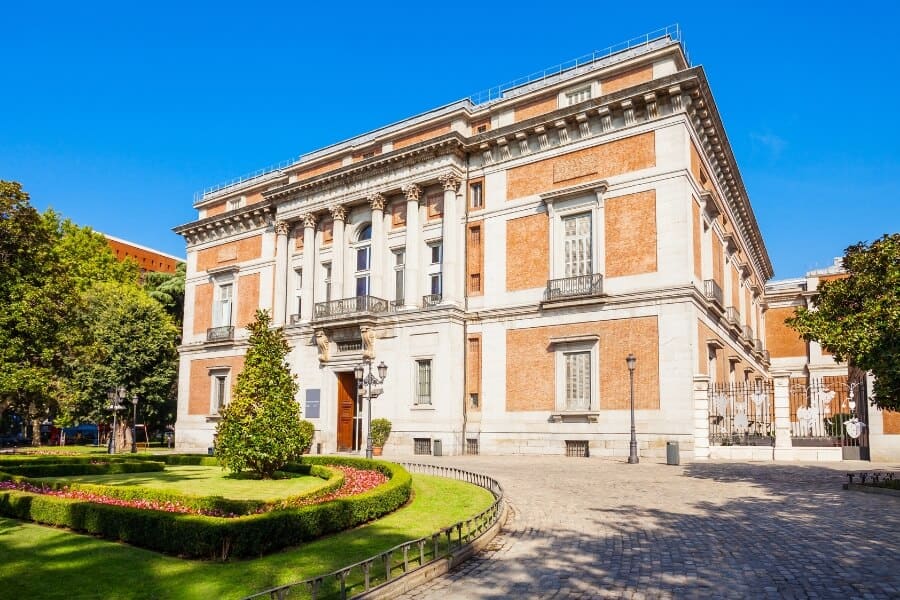
Weather in Madrid
Madrid experiences a continental Mediterranean climate with distinct seasons. Here's an overview of the typical weather in Madrid throughout the year:
- Spring (March to May):
- Spring starts off cool and gradually warms up. March can still be chilly, but temperatures rise as the season progresses.
- Average temperatures range from 7°C to 18°C (45°F to 64°F) in March, 9°C to 20°C (48°F to 68°F) in April, and 11°C to 23°C (52°F to 73°F) in May.
- Spring is characterized by mild, pleasant days and cooler nights. It's a great time to visit as the city comes to life with blooming flowers and outdoor events.
- Summer (June to August):
- Summer in Madrid can be hot and dry, with temperatures often exceeding 30°C (86°F). Heatwaves are not uncommon during this season.
- Average temperatures range from 17°C to 32°C (63°F to 90°F) in June, 20°C to 36°C (68°F to 97°F) in July, and 20°C to 35°C (68°F to 95°F) in August.
- Expect clear skies and plenty of sunshine, making it ideal for outdoor activities and enjoying the vibrant nightlife.
- Autumn (September to November):
- Autumn is a pleasant season with mild temperatures, although it can start warm in September and gradually cool down towards November.
- Average temperatures range from 17°C to 30°C (63°F to 86°F) in September, 13°C to 22°C (55°F to 72°F) in October, and 8°C to 15°C (46°F to 59°F) in November.
- Autumn is a great time for sightseeing, outdoor dining, and enjoying the changing colors of the trees in the parks.
- Winter (December to February):
- Winters in Madrid are relatively mild compared to other European cities, but it can still get cold, especially in January and February.
- Average temperatures range from 3°C to 12°C (37°F to 54°F) in December, 2°C to 11°C (36°F to 52°F) in January, and 4°C to 13°C (39°F to 55°F) in February.
- Occasional rainfall and even some snowfall can occur in winter, although snow is not common.
It's important to note that these are average temperatures, and actual weather can vary from year to year. When planning a trip to Madrid, it's a good idea to check the weather forecast closer to your travel dates for more accurate information.
How to Get to Madrid?
- By Air:
- Adolfo Suárez Madrid-Barajas Airport (MAD): This is the main international airport serving Madrid. It's well-connected to major cities around the world. Once you arrive at the airport, you can take a taxi, metro, or bus to reach the city center.
- By Train:
- High-Speed Trains (AVE): Spain has a well-developed high-speed train network (AVE) that connects major cities, including Madrid. Trains are fast, efficient, and comfortable. The Madrid Atocha station is a major hub for high-speed trains.
- Regional Trains: If you're traveling from nearby cities or regions, you can opt for regional trains that connect Madrid with various towns and cities in Spain.
- By Bus:
- Long-Distance Buses: Madrid has a central bus station, Estación Sur de Autobuses, which serves as a hub for long-distance buses from different parts of Spain and neighboring countries. Bus travel can be a cost-effective option.
- By Car:
- If you prefer driving, you can reach Madrid by car. Spain has an extensive road network, and major highways connect Madrid with other cities in the country and Europe. However, traffic congestion can be an issue in the city, so plan accordingly.
Best Flights To Madrid
Quickly search the best flights from the widest selection of airlines flying to Madrid. Regardless of what airline you go with, you can save money by comparing. Skyscanner is the best airline price comparison service specifically for Madrid.
How to Get Around Madrid?
Getting around Madrid is convenient and efficient thanks to its well-developed public transportation system and other transportation options. Here's a guide on how to get around in Madrid:
- Metro:
- The metro has multiple lines covering the entire city, making it easy to access popular tourist destinations and neighborhoods. The stations are well-marked and equipped with ticket machines and information booths.
- Buses:
- The bus network in Madrid is extensive and covers all areas of the city, including areas not served by the metro. EMT Madrid operates the bus services.
- Buses can be a great way to reach specific destinations or neighborhoods. You can use the same public transport card (like the MetroCard) for both metro and bus rides.
- Cercanías (Commuter Trains):
- Cercanías is a network of commuter trains that connect Madrid with its suburbs and nearby towns. It's operated by Renfe.
- Cercanías trains are useful if you plan to visit areas outside the city center or if you're staying in one of the suburban areas.
- Taxis and Ride-Sharing:
- Taxis are readily available throughout Madrid. You can hail them on the street, find them at taxi stands, or use ride-sharing apps like Uber and Cabify for a convenient and comfortable ride.
- Taxis are a good option for late-night travels or when traveling in a group.
- Bicycle Rentals and Bike-Sharing:
- Madrid has a growing bicycle culture, and there are many bike lanes and paths throughout the city. You can rent a bicycle from various rental shops or use bike-sharing programs like BiciMAD.
- Biking is a great way to explore the city and visit parks and landmarks at your own pace.
- Walking:
- Madrid is a walkable city, especially in the central areas. Many attractions, shops, restaurants, and cafes are within walking distance of each other, allowing you to explore on foot.
- Car Rentals:
- If you prefer driving, you can rent a car from various car rental agencies. However, note that driving in the city center can be challenging due to traffic and limited parking spaces.
- Tourist Hop-On Hop-Off Bus:
- Consider using the hop-on hop-off tourist buses, which take you to major attractions and provide commentary in multiple languages. This option is ideal for tourists who want a guided tour of the city.
Madrid has an extensive and efficient metro system, operated by Metro de Madrid. It's one of the fastest ways to move around the city and reach various attractions.
Using a combination of these transportation options will allow you to navigate Madrid easily and efficiently, ensuring you can explore the city and visit its attractions comfortably.
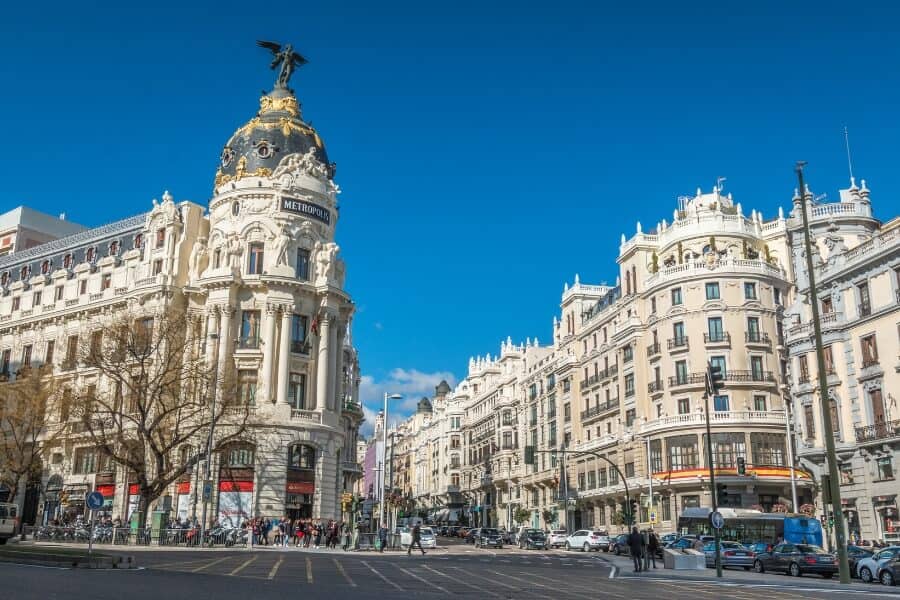
How Much Time Should I Spend in Madrid?
The ideal amount of time to spend in Madrid largely depends on your preferences, interests, and the pace at which you like to travel. Here are some recommendations based on various factors:
- Quick Visit (1-2 Days):
- If you're short on time, a quick visit of 1 to 2 days can give you a taste of Madrid's highlights. Focus on the major attractions such as the Royal Palace, Puerta del Sol, Plaza Mayor, Prado Museum, and Retiro Park.
- Standard Visit (3-4 Days):
- A standard visit of 3 to 4 days allows for a more thorough exploration of the city. You can delve deeper into the major attractions, explore additional museums, experience the local cuisine, stroll through various neighborhoods, and attend a flamenco show.
- In-Depth Exploration (5+ Days):
- For a more immersive experience, consider spending 5 days or more in Madrid. This will give you time to explore the city at a leisurely pace, visit lesser-known tourist attractions, venture into day trips to nearby cities or towns (like Toledo or Segovia), and experience the local lifestyle in a more relaxed manner.
Factors to Consider:
- Interests: Consider what interests you the most - art, history, gastronomy, nightlife, etc. Tailor your stay to include activities and attractions that align with your interests.
- Day Trips: If you plan to do day trips to nearby towns or cities, factor in the additional time required for those excursions. Some day trips can take a full day, so plan accordingly.
- Season: Depending on the season, the length of stay might vary. During peak tourist seasons, you might want to plan more time to account for longer lines and crowds at attractions.
- Relaxation vs. Sightseeing: Consider your travel style. Some people prefer a more relaxed pace, while others like to pack their days with activities. Plan your itinerary accordingly.
Ultimately, Madrid is a diverse city with much to offer, and the duration of your stay should allow you to make the most of your desired experiences. It's always a good idea to plan your itinerary for Madrid in advance, but also leave some room for spontaneous exploration and relaxation.
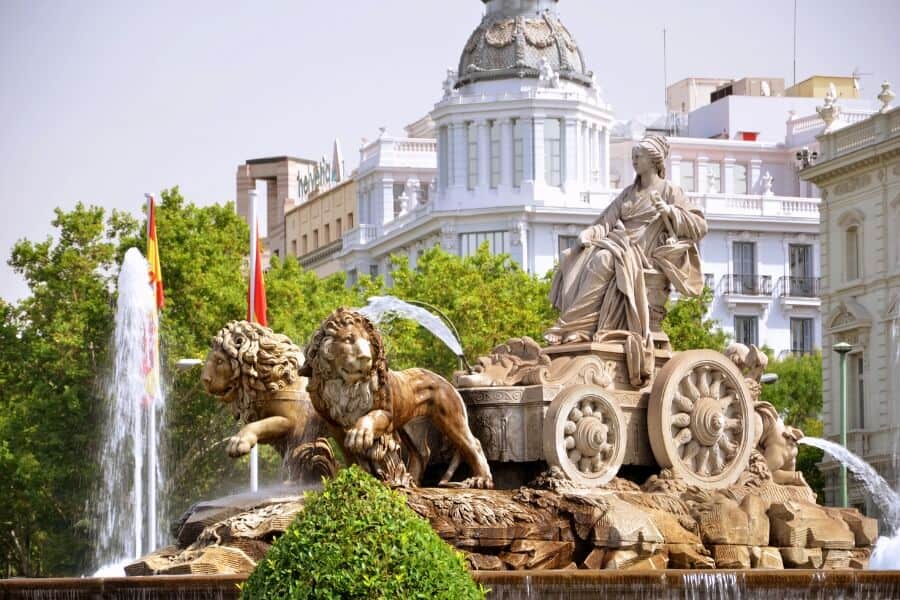
What Should I Do on My First Trip to Madrid?
Your first trip to Madrid is an exciting opportunity to explore this vibrant city and immerse yourself in its rich history, culture, and culinary delights. Here's a suggested itinerary to make the most of your first trip to Madrid:
Day 1: Explore the Historic Center
- Morning:
- Start your day at Puerta del Sol, the symbolic center of Madrid. Take in the atmosphere and maybe grab breakfast at a nearby café.
- Visit Plaza Mayor, an iconic square with stunning architecture and lively atmosphere. Explore the surroundings and maybe enjoy a traditional Spanish coffee.
- Midday:
- Head to the Mercado de San Miguel, a historic market, for a variety of Spanish tapas and local treats.
- Walk to the nearby Royal Palace (Palacio Real), the official residence of the Spanish royal family. Explore its stunning rooms, halls, and the beautiful Sabatini Gardens.
- Afternoon:
- Visit the renowned Prado Museum, one of the world's premier art galleries, featuring an extensive collection of European art.
- Stroll through Retiro Park, a vast and beautiful green space. Enjoy a relaxing time by the lake, rent a rowboat, or simply take a leisurely walk.
- Evening:
- Head to the vibrant district of La Latina for dinner. Enjoy tapas and traditional Spanish cuisine at one of the many local restaurants or tapas bars.
- End your day with a leisurely walk around La Latina and soak up the lively atmosphere of the nightlife.
Day 2: Art, Culture, and Culinary Delights
- Morning:
- Begin your day with a visit to the Reina Sofía Museum, known for its modern and contemporary art collection, including Picasso's famous Guernica.
- Explore the nearby Lavapiés neighborhood, known for its multicultural vibe and diverse food scene. Consider having lunch in one of its eclectic eateries.
- Midday:
- Walk to the Atocha Railway Station, a beautiful historical building, and nearby visit the Botanical Garden for a peaceful and scenic experience.
- Afternoon:
- Visit the Thyssen-Bornemisza Museum, which houses an impressive collection of European art from the 13th to the late 20th century.
- Take a leisurely stroll down Gran Vía, Madrid's main shopping street, and indulge in some shopping or people-watching.
- Evening:
- Experience traditional Spanish flamenco at a local tablao for a memorable and authentic cultural performance.
- Enjoy a delightful dinner at a traditional Spanish restaurant and savor a variety of tapas and dishes.
This itinerary provides a mix of major attractions, cultural experiences, art appreciation, and culinary delights, giving you a taste of what Madrid has to offer on your first trip. Adjust the schedule based on your preferences and the time you have available.
What Are Some Hidden Gems to See in Madrid?
Madrid is a city with many hidden gems and lesser-known attractions that offer a unique and off-the-beaten-path experience. If you're looking to explore beyond the typical tourist spots, here are some hidden gems to discover in Madrid:
- Mercado de Motores:
- Located at the Railway Museum, this market takes place on select weekends. It combines vintage shopping, art, live music, and food stalls in a unique setting amid old train carriages and locomotives.
- Círculo de Bellas Artes Rooftop Terrace:
- Head to the rooftop of Círculo de Bellas Artes for panoramic views of Madrid's skyline. It's a lesser-known spot that offers a fantastic vantage point, especially during sunset.
- El Capricho Park:
- A beautiful and tranquil park often overlooked by tourists, El Capricho Park is a hidden gem featuring landscaped gardens, sculptures, and a neoclassical palace. It's ideal for a peaceful retreat from the city's hustle and bustle.
- Temple of Debod (Templo de Debod):
- An ancient Egyptian temple relocated to Madrid, offering a picturesque setting in Parque del Oeste. It's especially enchanting during sunset and provides a unique contrast against the cityscape.
- Bar Tomate:
- A trendy and stylish restaurant with a contemporary design and a beautiful interior courtyard. It's a hidden gem for great food, cocktails, and a vibrant atmosphere.
- Mercado de Antón Martín:
- A local market with a diverse range of vendors selling fresh produce, gourmet products, and ready-to-eat meals. It's a great place to experience Madrid's food culture in a less touristy environment.
- Calle de Cava Baja:
- Explore this lively street in La Latina neighborhood, known for its traditional taverns, tapas bars, and a vibrant nightlife scene. It's a local favorite for authentic food and a relaxed ambiance.
- Lavapiés Street Art Tour:
- Lavapiés is a neighborhood known for its artistic vibe. Take a self-guided or guided street art tour to discover colorful murals and unique street art installations scattered around the area.
- Sorolla Museum (Museo Sorolla):
- A hidden gem showcasing the works of Spanish painter Joaquín Sorolla. The museum is housed in the artist's former home and studio, offering an intimate glimpse into his life and art.
- Mercado de San Ildefonso:
- A modern and trendy food market with a variety of international cuisine stalls and a rooftop terrace. It's a great spot to sample diverse flavors and enjoy the city views.
What Neighborhood Should I Stay in When I Visit Madrid?
Choosing the right neighborhood to stay in Madrid largely depends on your preferences, interests, and the type of experience you're seeking. Here are some popular neighborhoods in Madrid, each with its own unique characteristics:
Puerta del Sol and Gran Vía:
- Located in the heart of Madrid, this area is perfect if you want to be in the midst of the city's hustle and bustle. It's close to major attractions, shopping, theaters, and nightlife. Ideal for those who enjoy an energetic atmosphere.
Centro / Sol:
- The central district offers a mix of everything—historic sites, shopping, dining, and entertainment. It's perfect for first-time visitors who want to be within walking distance of many attractions.
Malasaña:
- Known for its hipster vibe, artistic flair, and vibrant nightlife, Malasaña is ideal for the young and the young at heart. It's filled with trendy boutiques, vintage shops, cafes, and eclectic bars.
Chueca:
- A lively and diverse neighborhood known for its LGBTQ+ friendly atmosphere, Chueca offers a vibrant nightlife scene, chic boutiques, and excellent dining options. It's great for those seeking an inclusive and energetic environment.
La Latina:
- Characterized by narrow streets, historic buildings, and a lively atmosphere, La Latina is renowned for its tapas bars, traditional taverns, and the famous El Rastro flea market (on Sundays). Perfect for food enthusiasts and those who appreciate a bohemian ambiance.
Retiro:
- Close to the beautiful Retiro Park, this area offers a more relaxed and residential ambiance. It's great if you prefer a quieter neighborhood while still being within reach of attractions.
Salamanca:
- A posh and upscale neighborhood known for high-end boutiques, luxury shopping, and elegant architecture. Salamanca is ideal for luxury travelers and those looking for a sophisticated experience.
Lavapiés:
- A multicultural and artsy neighborhood, Lavapiés is known for its diverse cuisine, street art, and a bohemian vibe. It's a great choice for those seeking a multicultural experience and a more affordable stay.
Paseo del Arte (Art Walk):
- This area encompasses the "Golden Triangle of Art" including the Prado Museum, Reina Sofía Museum, and Thyssen-Bornemisza Museum. It's perfect for art enthusiasts and those wanting easy access to Madrid's major art institutions.
Consider your interests, preferred atmosphere, and the activities you want to engage in when choosing a neighborhood. Whether you seek history, art, shopping, nightlife, or a mix of everything, Madrid has a neighborhood to suit your preferences.
Recommended Hotels In Madrid
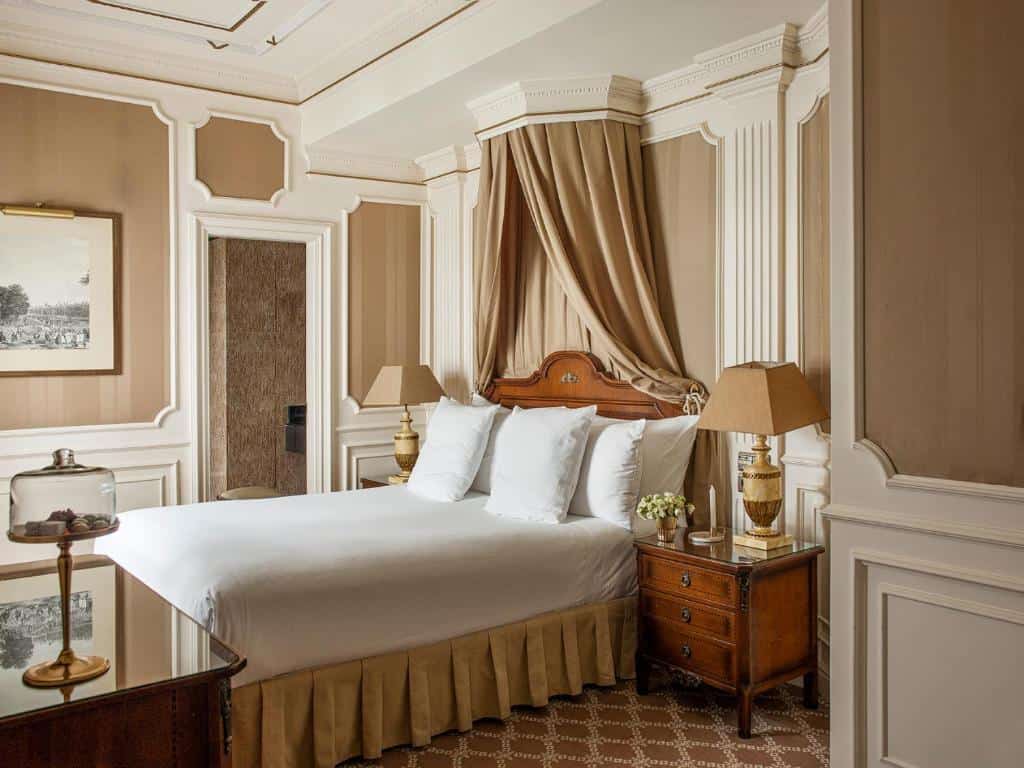
Hotel Fenix Gran Meliá
The Hotel Fénix Gran Meliá is a luxurious hotel located next to Plaza de Colón, in the Salamanca district of Madrid. It features elegant rooms and free Wi-Fi. All rooms have a flat-screen TV, iPod station, pillow menu, bathrobes and slippers.
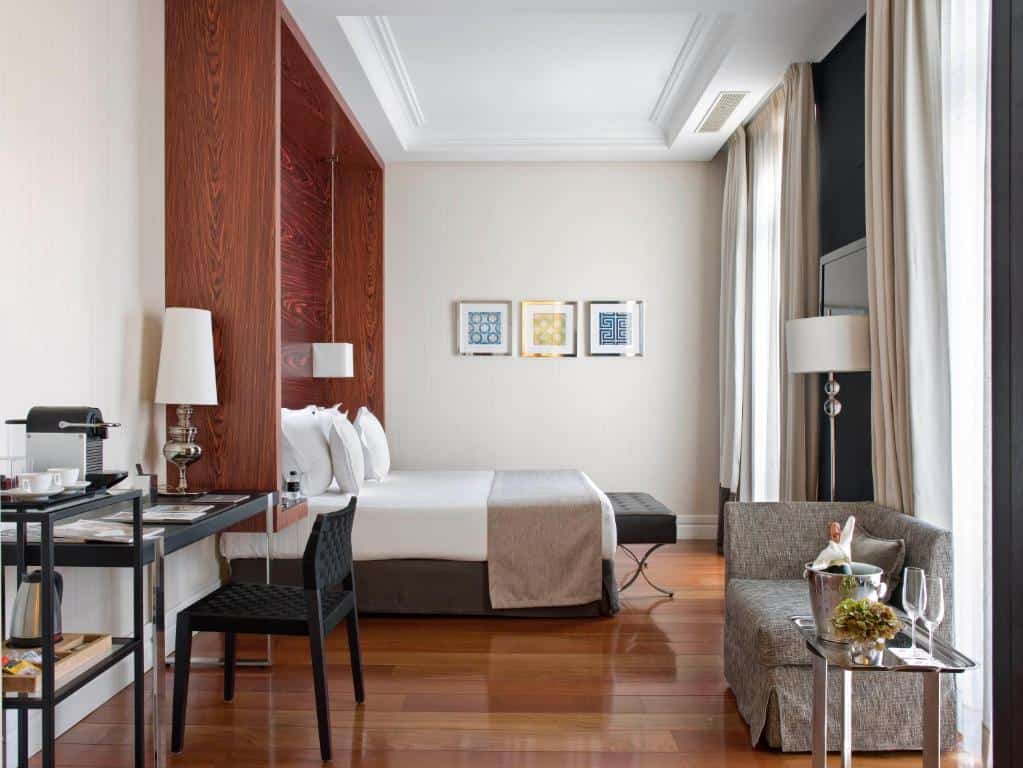
Hotel Único Madrid
The Hotel Único Madrid restaurant has 2 Michelin Stars. Located in Madrid’s Salamanca district, this restored 19th-century building offers free Wi-Fi, a modern gym and a charming garden courtyard.
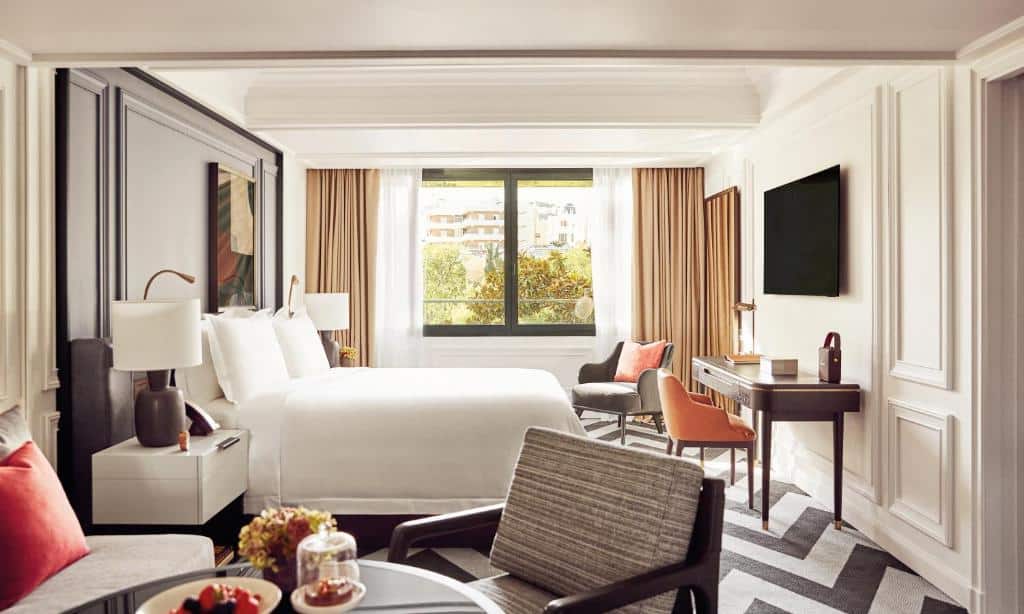
Rosewood Villa Magna
The elegant Rosewood Villa Magna offers exclusive rooms and suites in Madrid’s fashionable Salamanca area. The hotel boasts a spa, marble bathrooms and views onto Serrano Street or Castellana Avenue. The large, luxurious rooms have antique-style furniture and modern finishes.
What Is a Good Budget for a Trip to Madrid?
The budget for a trip to Madrid can vary widely based on several factors, including your travel style, preferences, accommodation choices, dining preferences, activities, and the duration of your stay. Madrid can cater to a range of budgets, from budget travelers to those seeking a more luxurious experience. Here's a breakdown of estimated daily expenses for different budget ranges:
- Budget Travelers:
- Accommodation: Hostels or budget guesthouses
- Food: Eating at inexpensive local eateries, street food, and markets
- Transportation: Using public transportation and walking
- Activities: Free or low-cost attractions, self-guided tours, and free walking tours
Estimated Daily Budget: $50 - $100 USD per person
- Mid-Range Travelers:
- Accommodation: Mid-range hotels or vacation rentals
- Food: Dining at a mix of mid-range and budget-friendly restaurants, sampling local cuisine
- Transportation: A mix of public transportation and occasional taxis or ride-sharing
- Activities: Visiting popular attractions, guided tours, museum entry fees
Estimated Daily Budget: $100 - $250 USD per person
- Luxury Travelers:
- Accommodation: Luxury hotels or high-end vacation rentals
- Food: Fine dining and gourmet experiences at upscale restaurants
- Transportation: Comfortable transportation options, including taxis, private transfers, or rental cars
- Activities: Private tours, exclusive experiences, theater or concert tickets
Estimated Daily Budget: $250+ USD per person
Keep in mind the following cost considerations when planning your budget for Madrid:
- Accommodation: Accommodation costs can vary greatly based on the type of lodging you choose—hostels, hotels, Airbnb, etc.
- Food and Dining: Dining at local restaurants, tapas bars, or high-end dining establishments will impact your budget. Opting for set menus or tapas can be a budget-friendly choice.
- Transportation: Madrid has an efficient public transportation system (metro, buses) which is relatively affordable. Consider getting a public transport card for discounted fares.
- Attractions and Activities: Many attractions have entry fees. Plan your must-visit sights and factor in these costs.
- Shopping and Souvenirs: Allocate a portion of your budget for shopping, souvenirs, and gifts.
- Miscellaneous: Include funds for unforeseen expenses, tips, and incidentals.
Remember to research specific costs for your intended activities, attractions, and preferences to create a more accurate budget for your trip to Madrid. It's always a good idea to plan ahead and track your expenses during your trip to stay within your budget.
Best Flights To Madrid
Quickly search the best flights from the widest selection of airlines flying to Madrid. Regardless of what airline you go with, you can save money by comparing. Skyscanner is the best airline price comparison service specifically for Madrid.
How to Save Money in Madrid?
Traveling to Madrid on a budget is entirely possible with some careful planning and smart choices. Here are several ways to save money during your visit to Madrid:
- Free Attractions and Activities:
- Take advantage of Madrid's many free attractions, such as Retiro Park, Temple of Debod, Plaza Mayor, Puerta del Sol, and the El Rastro flea market (on Sundays).
- Museums and Attractions Passes:
- Purchase a Madrid Card or museum pass for discounted or free entry to major attractions like the Prado Museum, Reina Sofía Museum, and Thyssen-Bornemisza Museum.
- Public Transportation:
- Use Madrid's efficient public transportation system, including the metro and buses, for an affordable way to get around the city. Consider purchasing a public transport card for discounted fares on multiple journeys.
- Walking Tours:
- Participate in free walking tours to explore the city and learn about its history and culture. Many guides work on a tip-only basis, allowing you to set your own budget.
- Eat Like a Local:
- Opt for traditional Spanish eateries and tapas bars, where you can enjoy small plates of local cuisine at reasonable prices. Avoid touristy areas for dining, as prices can be higher.
- Menu del Día:
- Take advantage of the "Menu del Día" offered at many restaurants during lunchtime. It's a set menu at a fixed price, often including multiple courses, making it a cost-effective choice.
- Local Markets:
- Visit local markets like Mercado de San Miguel or Mercado de Antón Martín for authentic Spanish food at reasonable prices. Sample a variety of tapas and local specialties.
- Picnics and Grocery Stores:
- Consider having picnics in parks using items from local grocery stores. This is not only economical but also allows you to experience Madrid's outdoor culture.
- Accommodation:
- Stay in budget-friendly accommodation options such as hostels, guesthouses, or Airbnb rentals. Booking in advance can often yield better rates.
- Discounts and Offers:
- Look out for discounts on attractions, tours, and activities. Check online platforms, tourist offices, and your accommodation for promotional offers.
- Student and Youth Discounts:
- If you're a student or a young traveler, make use of discounts offered at various attractions, transport services, and events.
- Tap Water:
- Save on bottled water by refilling a reusable water bottle with tap water, which is safe to drink in Madrid.
- Free Wi-Fi:
- Use free Wi-Fi available in cafes, restaurants, and public places to avoid excessive mobile data charges.
By incorporating these money-saving tips into your Madrid travel plans, you can have a fantastic experience without breaking the bank
How to Stay Safe in Madrid?
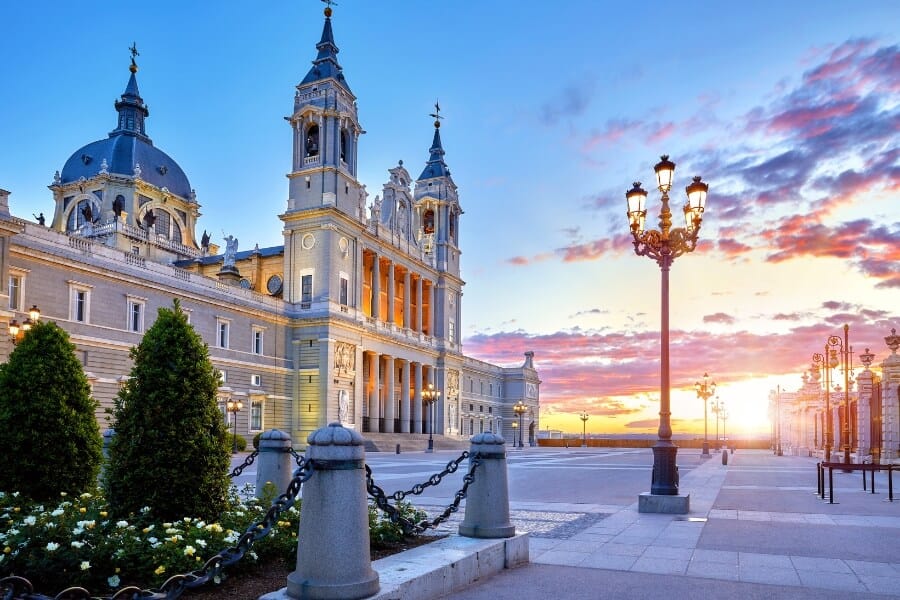
Ensuring your safety while visiting Madrid, or any city for that matter, is a priority to have a worry-free and enjoyable trip. Here are some tips to help you stay safe in Madrid:
- Be Aware of Your Surroundings:
- Stay alert and aware of what's happening around you. Avoid distractions like using your phone extensively in crowded areas.
- Use Reputable Accommodations:
- Choose well-reviewed, reputable hotels, hostels, or Airbnb accommodations in safe neighborhoods. Research the area's safety before booking.
- Secure Your Belongings:
- Keep your belongings secure and be cautious of pickpockets, especially in crowded places, public transportation, and tourist areas. Use anti-theft bags and money belts if necessary.
- Avoid Displaying Valuables:
- Minimize the display of valuable items like expensive jewelry, cameras, and electronics in public to avoid attracting unnecessary attention.
- Use Reliable Transportation:
- Use licensed taxis, reputable ride-sharing services, or public transportation. Be cautious of unmarked or unofficial taxis.
- Follow Traffic Rules and Signals:
- Pay attention to traffic signals and pedestrian crossings when walking or using public transportation. Drivers may not always strictly adhere to traffic rules.
- Know Emergency Numbers:
- Familiarize yourself with emergency numbers in Madrid, such as 112 (general emergency), and keep your embassy's contact information handy.
- Stay Informed about Current Events:
- Keep yourself updated on any current events or safety advisories in Madrid through reliable news sources or official government travel websites.
- Trust Your Instincts:
- If something doesn't feel right, trust your instincts and remove yourself from the situation. It's always better to be safe than sorry.
- Travel Insurance:
- Ensure you have comprehensive travel insurance that covers medical emergencies, trip cancellations, and other unforeseen events during your trip.
- Respect Local Customs and Laws:
- Familiarize yourself with local laws and customs to avoid unintentionally breaking any rules, which could lead to legal issues.
- Avoid Risky Areas at Night:
- Stay away from poorly lit or sketchy areas, especially at night. Stick to well-traveled routes and areas with good lighting.
- Stay In Groups:
- If possible, travel with a group, especially at night, to increase safety. Avoid isolated places and opt for well-populated areas.
- Health Precautions:
- Prioritize your health by following recommended vaccinations, staying hydrated, and taking necessary precautions against any local health risks.
- Language:
- Familiarize yourself with basic Spanish phrases and common expressions to facilitate communication and navigate the city more effectively.
What Are the Best Neighborhoods for Shopping in Madrid?
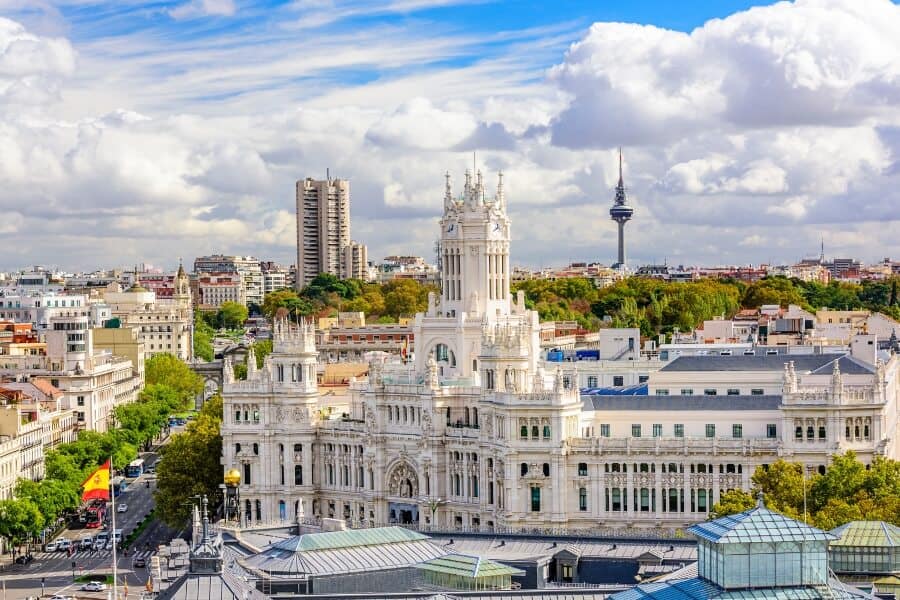
Madrid offers diverse shopping experiences, from luxury boutiques to traditional markets. Here are some of the best places to go shopping in Madrid:
- Salamanca:
- Known for its upscale shopping, Salamanca is the high-end fashion district. Calle Serrano and Calle de José Ortega y Gasset are famous for luxury brands like Chanel, Louis Vuitton, and Prada.
- Gran Vía:
- Gran Vía is Madrid's main shopping street, offering a mix of high-street stores, fashion boutiques, and international chains. It's great for fashion enthusiasts and those seeking a variety of shopping options.
- Chueca:
- Chueca is known for its trendy and avant-garde fashion scene. You'll find unique boutiques, vintage shops, and independent designers, making it a great neighborhood for fashion-forward shopping.
- Malasaña:
- Malasaña is a hipster neighborhood with a bohemian vibe, offering a range of eclectic boutiques, vintage stores, and alternative fashion. It's ideal for those seeking unique and retro fashion finds.
- Centro / Sol:
- The central district is home to major department stores like El Corte Inglés, FNAC, and other international retailers. Preciados Street is a popular shopping spot in this area.
- Puerta del Sol:
- Puerta del Sol and its nearby streets offer a mix of shopping options, from souvenir shops to fashion stores. It's a bustling area perfect for grabbing souvenirs and browsing.
- Barrio de las Letras:
- Known for its literary history, this neighborhood features boutique shops, bookstores, and antique shops. It's great for unique finds and literary-themed gifts.
- El Rastro:
- El Rastro is Madrid's famous flea market held on Sundays and public holidays. It's the perfect place to discover antiques, second-hand items, clothing, and unique souvenirs.
- Calle Fuencarral:
- Calle Fuencarral is a pedestrian shopping street offering a mix of international brands, trendy boutiques, and urban fashion. It's popular among young shoppers.
- Lavapiés:
- Lavapiés is a multicultural neighborhood where you can find diverse shops and boutiques selling unique crafts, ethnic clothing, and international products.
- Goya District:
- Goya District is another area known for luxury shopping, with prestigious boutiques and high-end stores catering to those looking for upscale fashion and lifestyle brands.
Best Flights To Madrid
Quickly search the best flights from the widest selection of airlines flying to Madrid. Regardless of what airline you go with, you can save money by comparing. Skyscanner is the best airline price comparison service specifically for Madrid.
What Food is Madrid Known For?
Madrid is renowned for its diverse and flavorful culinary offerings, deeply rooted in traditional Spanish cuisine. Here are some iconic dishes that Madrid is known for:
- Bocadillo de Calamares (Calamari Sandwich):
- A popular street food made with crispy fried rings of calamari served in a crusty bread roll. It's a staple snack in Madrid.
- Tortilla Española (Spanish Omelette):
- A classic Spanish dish made with eggs, potatoes, and sometimes onions. It's a staple tapa and is often served as a light meal or snack.
- Jamón Ibérico (Iberian Ham):
- A prized Spanish cured ham made from acorn-fed Iberian pigs. It's a quintessential element of Spanish cuisine and can be found in various forms and quality levels.
- Cocido Madrileño:
- A hearty stew made with chickpeas, various cuts of meat (pork, chorizo, blood sausage), and vegetables. It's often enjoyed in multiple courses and is a traditional dish in Madrid.
- Churros con Chocolate:
- Fried dough pastries (churros) dipped in thick, rich hot chocolate. It's a favorite breakfast or snack, especially during the colder months.
- Gambas al Ajillo (Garlic Shrimp):
- Shrimp sautéed with garlic, chili peppers, and olive oil. It's a popular tapa and bursting with flavor.
- Patatas Bravas:
- Fried potatoes served with a spicy tomato-based sauce (brava sauce) and often topped with aioli. It's a classic tapa loved by locals and visitors alike.
- Rabo de Toro (Bull's Tail):
- Slow-cooked, tender bull's tail stewed in a rich, flavorful sauce made with wine, tomatoes, and spices. It's a hearty and traditional dish.
- Salmorejo:
- A cold, creamy tomato soup made from ripe tomatoes, bread, garlic, olive oil, and garnished with hard-boiled eggs and jamón (ham) bits.
- Pisto:
- A hearty vegetable stew made from tomatoes, bell peppers, zucchini, onions, and sometimes eggplant, often topped with a fried egg.
- Cojonudo:
- A pintxo (snack) made with a slice of chorizo and a fried quail egg on a small slice of bread. It's a flavorful bite-sized treat.
- Sangria:
- A popular Spanish drink made with red wine, fruits, sugar, orange juice, and brandy. It's refreshing and perfect for warm days.
- Paella:
- Although paella is more commonly associated with the Valencia region, you can find variations of this famous rice dish in Madrid as well.
FAQ
Q: Are Madrid locals friendly to tourists?
A: As someone who has had the pleasure of visiting Madrid multiple times, I can confidently say that locals in Madrid are incredibly friendly and welcoming to tourists. From my very first visit, I was struck by how warm and helpful the Madrileños were. Whether it was asking for directions or recommendations on where to eat, they always took the time to patiently assist me, even if there was a language barrier.
Q: What you need to know before going to Madrid?
A: One of the most important things I discovered before going to Madrid was the fact that Spanish is the official language spoken in the city. While many locals do speak English, it was essential for me to learn some basic Spanish phrases and expressions to navigate through daily interactions. This proved extremely helpful when ordering food at local restaurants or asking for directions from friendly Madrileños.
Q: What is cool about Madrid?
A: One of the coolest aspects of this city is its incredible nightlife scene. As dusk falls, the streets come alive with an energy that is infectious. From trendy rooftop bars to underground clubs with cutting-edge music, Madrid offers something for every taste. I remember one unforgettable night when my friends and I stumbled upon a hidden jazz club in Malasaña. The intimate space was filled with passionate musicians and enthusiastic crowds, creating an atmosphere that was electric and unforgettable.
Q: What is the safest area in Madrid for tourists?
A: While Madrid overall is a safe city for travelers to explore, Salamanca and Chamberí stand out as particularly secure areas within the capital. These neighborhoods provide not only safety but also charm and beauty to enhance any visitor's experience in Madrid. Whether seeking high-end shopping or cozy squares filled with local flavors, these districts offer a serene environment that allows tourists to enjoy all that Madrid has to offer with peace of mind.
Q: Is Madrid bad for pickpockets?
A: Madrid is unfortunately notorious for its pick pocketing problem. While it may not be fair to label Madrid as bad for pickpockets, the city does have a higher incidence of petty theft compared to other European cities. This can largely be attributed to the sheer number of tourists that flock to Madrid's popular attractions and bustling streets on a daily basis.
Recommended Hotels In Madrid

Hotel Fenix Gran Meliá
The Hotel Fénix Gran Meliá is a luxurious hotel located next to Plaza de Colón, in the Salamanca district of Madrid. It features elegant rooms and free Wi-Fi. All rooms have a flat-screen TV, iPod station, pillow menu, bathrobes and slippers.

Hotel Único Madrid
The Hotel Único Madrid restaurant has 2 Michelin Stars. Located in Madrid’s Salamanca district, this restored 19th-century building offers free Wi-Fi, a modern gym and a charming garden courtyard.

Rosewood Villa Magna
The elegant Rosewood Villa Magna offers exclusive rooms and suites in Madrid’s fashionable Salamanca area. The hotel boasts a spa, marble bathrooms and views onto Serrano Street or Castellana Avenue. The large, luxurious rooms have antique-style furniture and modern finishes.
PLAN YOUR TRIP TO MADRID
Book Your Hotel In Madrid
You can book your hotel in Madrid with Booking.com as they have the biggest inventory and best deals. If you want to stay somewhere other than a hotel, they also return the cheapest rates for accommodations like guesthouses, hostels and apartments.
Book Your Flight To Madrid
Use Skyscanner to find the best flights to Madrid. They are my favorite search engine because they search websites and airlines around the globe so you always know you get the best rates.
Need a Rental Car In Madrid?
Here is a budget-friendly car rental resource. No matter where you’re traveling, you’ll be able to find the best car rentals in Madrid here.
Looking for an Airport Transfer Service In Madrid?
If you are looking for a convenient and affordable option to get to and from the airport in Madrid, here you will find all the answers to book your next airport transfer in Madrid.
Don’t Forget Your Travel Insurance
Travel insurance will protect you against illnesses, an injury, luggage theft, and even trip cancellations. It’s a comprehensive protection in case anything goes wrong during your trip. I never visit Madrid without it as I’ve had to use it several times in the past. My favorite travel insurance companies that offer the best service and value are:
Looking for the Best Travel Companies to Save Money With?
Check out my resource page for the best companies to use when you visit Madrid. I list all the ones I use to save money when I’m taking a trip. They will save you money when you travel too.
Want More Information on Spain:
Be sure to visit our Spain Travel Guide for even more travel tips.

